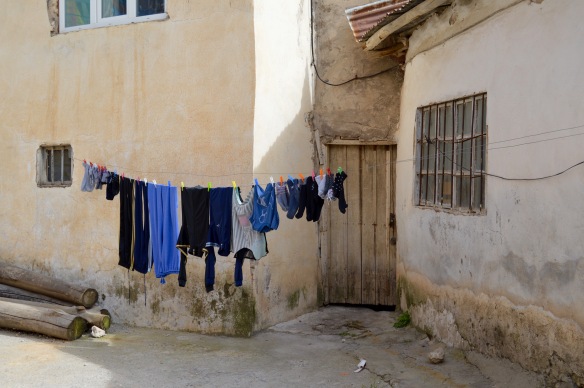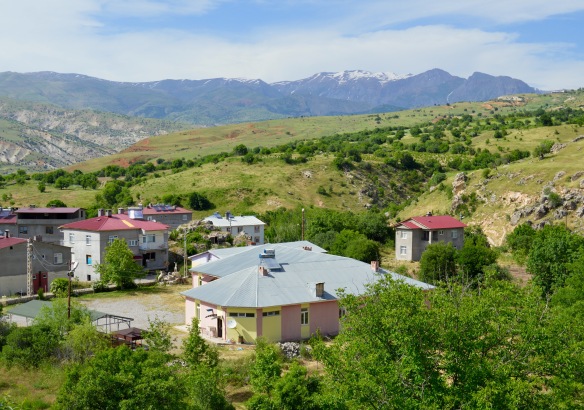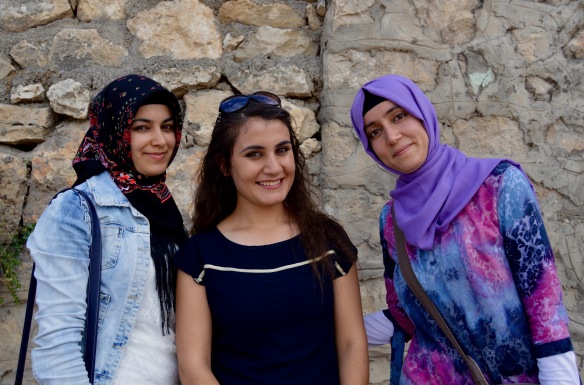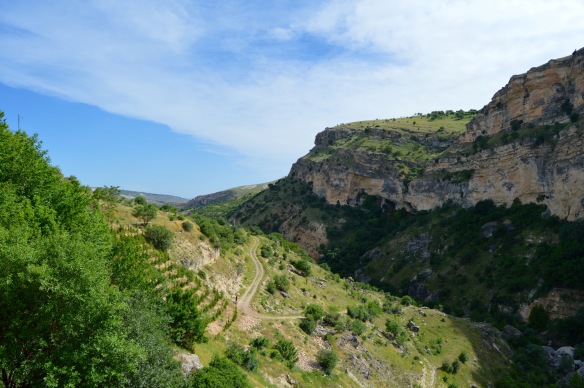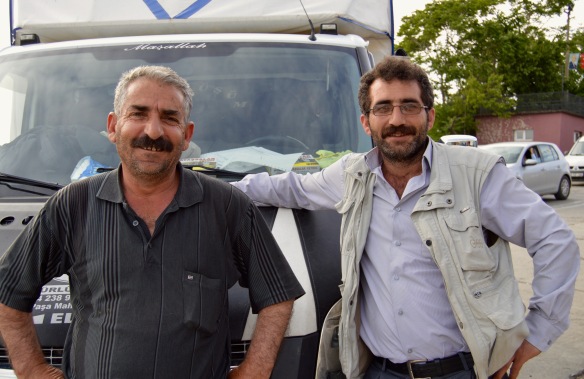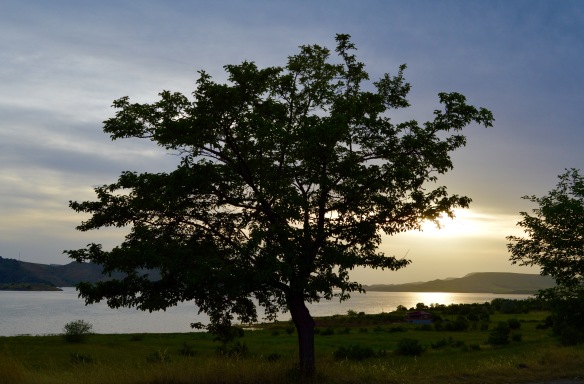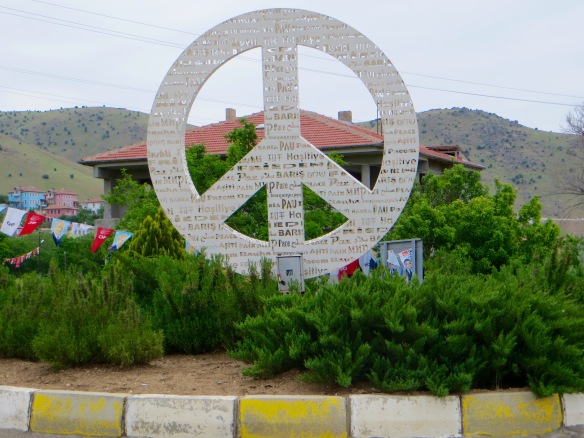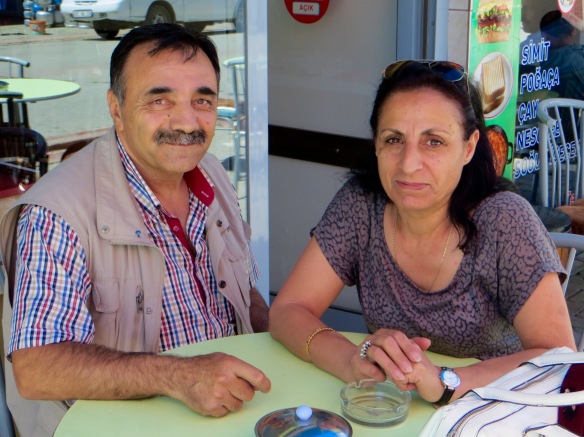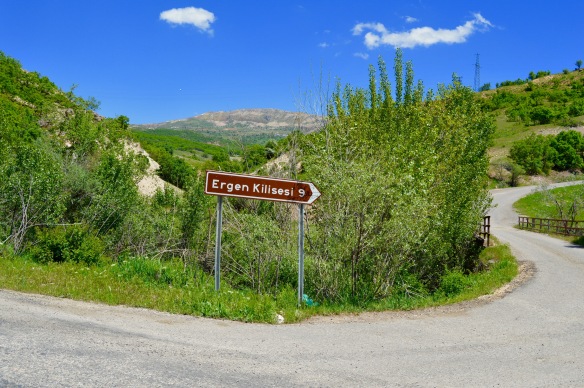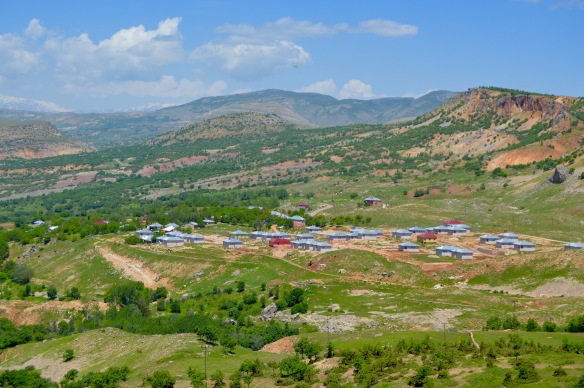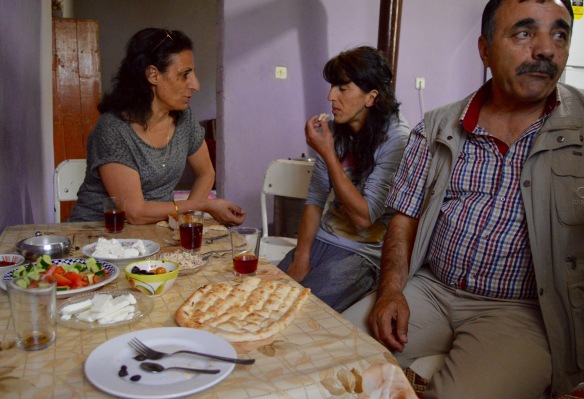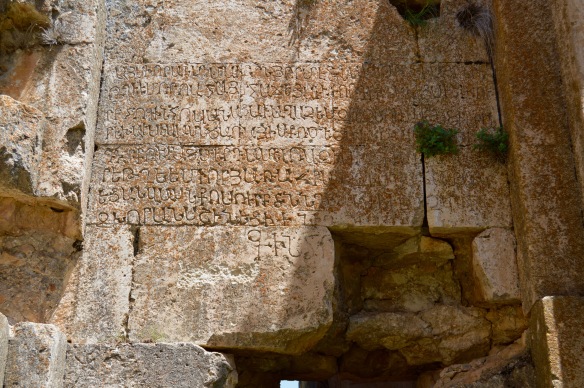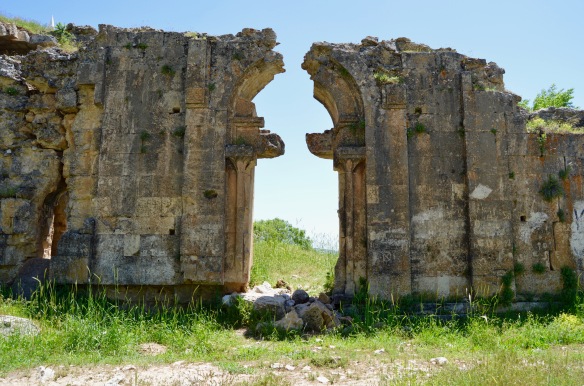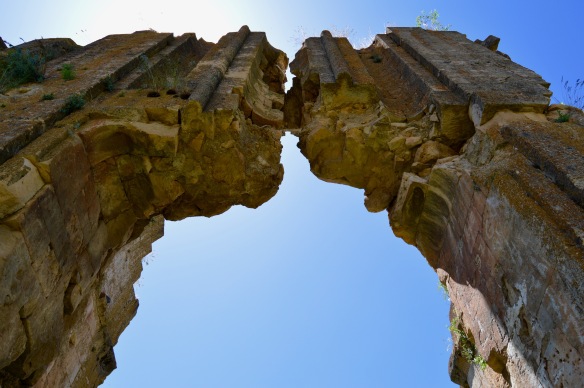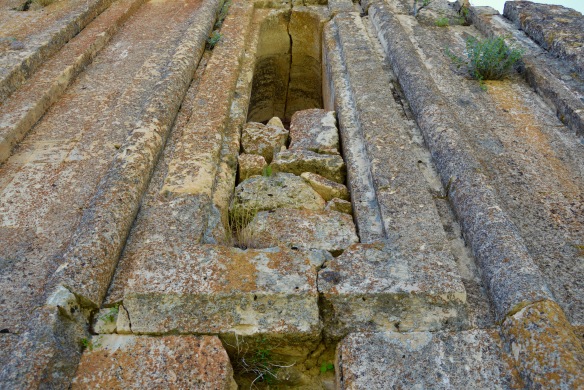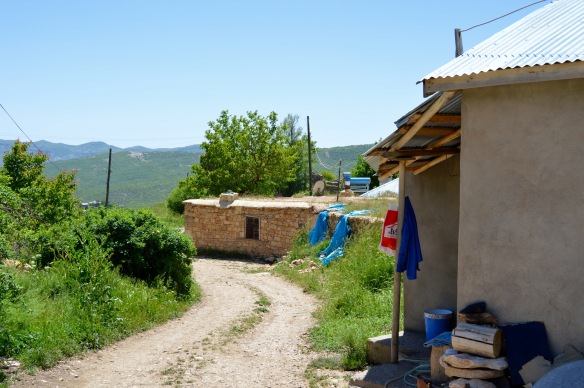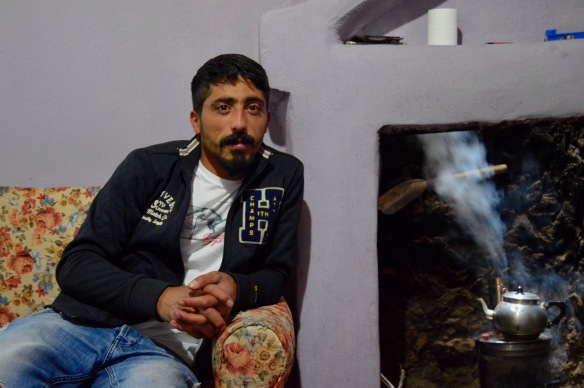I had an excellent night’s sleep because of the comfortable bed and the quiet room, so was rested enough by 6.30am to walk to the ferry terminal to take more photos of the ferries and the castle. Because breakfast at the hotel was not served until 8.00am, I walked toward the roundabout with the peace sign, but, before getting that far, took a right turn along a dirt road that led toward the centre of Pertek past small apartment blocks, houses in large gardens and farms where families kept sheep and a few cattle. As the road ascended, the views of the reservoir and the castle steadily improved. Every so often, children waited to be picked up in a minibus and taken to school.
Before the reservoir had filled with water, two mosques were dismantled from the slopes on which old Pertek lay and reassembled in the modern town (in other words, the mosques lay on the slopes below the castle. The slopes were now below the level of the water, as were ruins including a church and a hamam). I caught glimpses of both the mosques. They had their origins in the 16th century. Baysungur Camii was a domed cube with a three-domed portico and a minaret. The portico’s walls and the minaret’s shaft were constructed with bands of chocolate-coloured and cream-coloured stone, but the walls of the prayer hall comprised of rubble stone. Celebi Ali Camii had some similarities with Baysungur Camii, but an iwan and a cesme helped to make it distinctive in appearance.
For breakfast, I was directed to the café and lokanta built in the large garden overlooking the reservoir the other side of the road from the hotel. I sat at a table facing the reservoir, the castle and the hills to the south-west and, about 15 minutes later, was given tea and a tray of food. For a hotel expensive by Turkish standards the food was not very imaginative, but, with a generous portion of bread to go with the tomatoes, cucumber, olives, three types of cheese, chips, boiled egg, honey in the comb, cherry jam, tea and water, I had no reason to complain. However, cloud was building up and turning the sun a little hazy. I expected the day to involve a lot of walking, so perhaps the cloud would prove a blessing in disguise.
My destinations for the day were Ulu Kale, about 10 to 15 kilometres from Cemisgezek, and Sagman, about 15 kilometres from Pertek. Both destinations lay off the main road to Cemisgezek, but the previous day’s travels had given me the opportunity to identify precisely where both roads to my destinations diverged. I had resolved to visit Ulu Kale first because it was further from Pertek.
Just before 9.00am, I left the hotel for the roundabout with the peace sign and, ten minutes after arriving there, a quietly spoken man driving an old Tofas offered me a lift to the junction for Dere. When I got out of the car, I was almost as far as the small supermarket where I had bought the ice cream the day before. I walked a short distance, then a car stopped with four men inside. The men were going to Cemisgezek to undertake a day’s work and they each had a small briefcase to confirm they were civil servants or professionals of some importance. Because the junction for Ulu Kale was only 3 or 4 kilometres from Akcapinar near where I had been the day before, I was taken most of the way to Cemisgezek. The journey confirmed that the road from Pertek to Cemisgezek was one of exceptional beauty and interest.
Because the car in which we travelled was very new and the driver wanted to show off his skills at the wheel, it was about 10.20am when I arrived at the junction for Ulu Kale. The sign at the bottom of the road suggested that the village was only 4 kilometres away, but by the time I arrived in its centre, it felt as if I had walked 5 or 5.5 kilometres. For most of the way, the ascent was merely steady and a lot of time was spent at or near the highest point along a ridge. I therefore secured excellent views of Payamduzu on the way to Akcapinar and Cemisgezek, and north toward snow-smudged mountains in the milli parki. The cloud cover remained quite thick, which imbued many a view with a grey tinge, but at least it was cool and the views extensive, not least over the reservoir. I encountered a few large flocks of sheep and goats. Once, I was worried that large dogs protecting a flock might make their way in my direction because they had seen me and were barking in a threatening way. However, they decided to stay close to their shepherd instead.
I rounded a corner and was at the westernmost edge of Ulu Kale. In recent decades, the village had shifted from its original position immediately below basalt cliffs crowned by the scant remains of a castle to a more accessible and gently sloping shelf looking south. However, the remains of the original village and the much larger new one lay in a bowl with cliffs and steep slopes rising to the west, the north and the east. Once the houses and other facilities of the village somewhat abruptly concluded, fields, orchards and pasture led toward a river to the south. At the entrance to the village on the west side was a most unusual sight in a Turkish village, identical modern houses arranged in regular fashion along new roads that strictly belonged in a new suburb in one of the large conurbations far to the west. The pitched roofs, brightly painted render walls, satellite dishes and small gardens behind wire fences would have looked perfectly at home in parts of Bursa or Eskisehir. Or, with minor tweaking, in Birmingham in the UK.
Despite Ulu Kale being enclosed by cliffs and slopes immediately to the north, open views existed south-east and south-west, and the hills to the south were far enough away to create a welcome sense of spaciousness. Although the most interesting houses were the ones in the original village (they had been built with stone and were large), only a few remained and they looked as if they had been abandoned. The houses in the new village were of interest because a mixture of stone, mudbrick, concrete, render, wood, corrugated iron and flat sheets of metal have been used to good visual effect. Most houses had a patch of garden surrounding them where trees, flowers and a few vegetables could be grown.
Between the original village and the new one was a turbe with an octagonal ground plan. According to Sinclair, it was built in 1550 for someone called Ferruhsad Bey:
Three courses of a rich red stone run round the trunk. Two large windows in arched recesses to e. and w. Beside the mihrab, which is partly lost, there are niches in the se. and sw. walls of the interior. The brick interior dome is revealed by the loss of the exterior pyramidal cap. There is a small crypt.
Not far from the turbe was a ruin described to me as a church. I could find nothing to confirm what the ruin had been, but Sinclair describes a church more or less where the ruin was. He writes that it was:
Single nave, one rib. Semi-circular apse, ruined. Entrance wall mostly fallen. Large blocks used. Probably 17th or 18th century.
Photos of Ulu Kale on the internet taken a few years ago confirm that many old houses, even then in a very neglected state, had disappeared altogether, and it was obvious from Sinclair’s monumental study of eastern Turkey that very little of the castle survived. However, I was glad I had made the effort to visit the village, not least for its dramatic natural surroundings. I noticed that a road meandered along the river in an easterly direction leading after a few kilometres to Bozagac and, if nothing else, the scenery must be very rewarding. From Bozagac, a road led to the one between Pertek and Cemisgezek. Could this be a round walk for a future visit? Perhaps.
So little traffic went from Ulu Kale to the Pertek to Cemisgezek road during the day that I had to walk all the way to the junction, but at least I was going downhill most of the time and could enjoy extensive views of the reservoir. Once at the junction, I had to wait only a short time for a lift all the way to the junction for Sagman. I was travelling with a man of local importance (he toured the region to confirm that road works were completed to a satisfactory standard) because he was in a new and very comfortable car with a chauffeur. The chauffeur said that he played professional football for a club in a league two levels below the top-flight clubs and that his job as a chauffeur terminated once the football season began. Both men were Alevis. They combined friendliness with a reflective frame of mind, but warned me that most people in Sagman were Sunni Muslims.




















